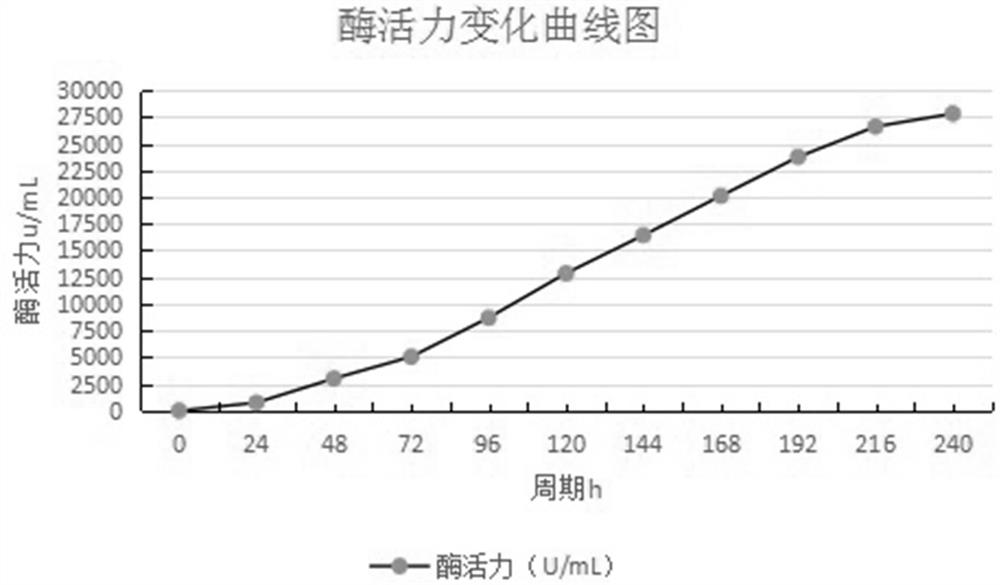A Laccase-Producing Mutant Thromba Trametes and Its Application
A technology of Trametes rubrum and laccase, applied in the direction of enzymes, fungi, oxidoreductase, etc., can solve the problems of high price and limited application of laccase
- Summary
- Abstract
- Description
- Claims
- Application Information
AI Technical Summary
Problems solved by technology
Method used
Image
Examples
specific Embodiment
[0024] The application will be further explained below in conjunction with the examples. Before introducing specific embodiments, some experimental backgrounds involved in the following embodiments are briefly described as follows.
[0025] Experimental reagents:
[0026] 10mmol / L 2,6-dimethoxyphenol (DMP), 0.1mol / L citric acid phosphate buffer (pH3.5), conventionally prepared; however, it should be noted that 2,6-dimethylformaldehyde is prepared After the solution of oxyphenol (DMP), it needs to be stored in the refrigerator in a brown bottle for one week before use.
[0027] Determination of laccase enzyme activity (DMP method)
[0028] The definition of enzymatic activity is: under certain temperature and pH conditions, the amount of enzyme required to produce 1 μmol of product by oxidation within 1 min is one enzymatic activity unit;
[0029] Since laccase can oxidize the substrate 2,6-dimethoxyphenol (DMP) to 2,6-dimethoxyphenolquinone, the substance has a maximum abso...
Embodiment 1
[0037] In this example, the mutagenesis, selection and acquisition process of the Trametes rubrum YSQ8 strain provided in this application is briefly introduced as follows.
[0038] The T. rubrum YSQ8 strain provided in this application is based on the existing two strains of T. rubrum with different phenotypes (YSQ6-105, YSQ7), and is obtained by plastid fusion and directional breeding. The specific process is briefly described as follows.
[0039] (1) Preparation of protoplasts
[0040] Take the two preserved starting strains (YSQ6-105, YSQ7), suspend them with 0.6M sorbitol osmotic pressure stabilizer (0.1M citric acid buffer+0.6M sorbitol+0.01M EDTA), and put them on ice for later use;
[0041] Then add lysozyme 1.2%, helicase 0.8%, cellulase 0.8%, and enzymolysis at 30°C for 6 hours to prepare protoplasts for later use;
[0042] In the preparation process, the common medium for protoplast culture is: potato 200g, glucose 20g, agar 20g, water 1000mL; the regeneration medi...
Embodiment 2
[0063] On the basis of the strain obtained by screening in Example 1, the inventor further optimized the fermentation process to which it was adapted to further improve the fermentation enzyme production capacity of the strain. The specific process is introduced as follows.
[0064] (1) Strain activation and preparation of seed solution
[0065] The preserved Trametes rubrum YSQ8 mycelium was inoculated in a PDA culture bottle, fermented and cultured at 30° C., 220rpm for 5d, transferred to a sterile bottle, and the seed bottle of the seed tank was obtained;
[0066] Then carry out the preparation of the first-class seed liquid, specifically: inoculate the seed bottle into the PDA medium of the first-class seed tank, and ferment for 56h at 30°C and 180rpm;
[0067] Then, the secondary seed liquid was prepared, specifically: the primary seed liquid was inoculated into the PDA medium of the secondary seed tank under aseptic conditions, and fermented at 30° C. and 160 rpm for 50...
PUM
 Login to View More
Login to View More Abstract
Description
Claims
Application Information
 Login to View More
Login to View More - R&D
- Intellectual Property
- Life Sciences
- Materials
- Tech Scout
- Unparalleled Data Quality
- Higher Quality Content
- 60% Fewer Hallucinations
Browse by: Latest US Patents, China's latest patents, Technical Efficacy Thesaurus, Application Domain, Technology Topic, Popular Technical Reports.
© 2025 PatSnap. All rights reserved.Legal|Privacy policy|Modern Slavery Act Transparency Statement|Sitemap|About US| Contact US: help@patsnap.com

